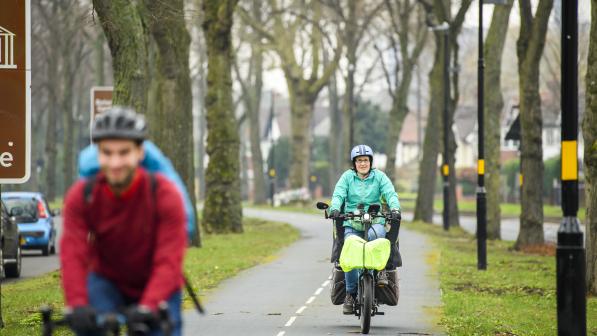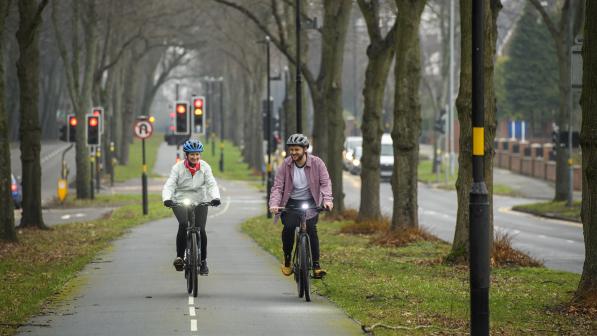What does the latest round of active travel funding mean for local authorities in England?

Active Travel Fund 4 (ATF4) is the latest funding round of Westminster Government’s second Cycling and Walking Investment Strategy. Bankrolled by the Department for Transport (DfT), with allocations determined by Active Travel England (ATE), this new capital funding is ring-fenced for 265 approved schemes and expected to generate up to 16 million extra walking and cycling trips every year.
Sounds good, right? However, the cynics amongst us may ask where this ‘new’ funding has come from.
Smoke and mirrors
In March, Westminster announced investment in cycle lanes, junction safety improvements and other active travel projects would be reduced from £308m to just £100m over the next two years, the remaining £100 accounting to a miniscule 0.25% of investment announced for all transport infrastructure. Cycling UK, alongside the Walking and Cycling Alliance (WACA), wrote to the Prime Minister, calling for these cuts to reversed urgently. We also ran a supporter action, during which close to 3,000 of you wrote to your MP urging them to speak up for investment in cycling, which led to this issue being raised in parliamentary debate.
While the local authorities who received this funding will undoubtedly have breathed a sigh of relief to have finally received last year’s funding for active travel, cycling and walking in England still faces a dramatic reduction in funding, unless the government reverses its cuts announced in March
Duncan Dollimore, Cycling UK head of campaigns
The £200m pot announced last Friday, which Cycling UK have found to in fact only add up to £170.6m, is framed as ‘new funding’ in the DfT’s statement. What the allocations reflect are active travel projects that were bid for in the last financial year which ended on 31 March 2023, with the money being released to local authorities on that final day. The announcement then delayed due to the 'purdah' period before May's local elections, when national and local politicians are meant to refrain from policy announcements.
Ultimately, it’s a good thing to see projects funded to enable active travel, allowing a lot more people to go about many of their everyday journeys by walking and cycling as a safe and convenient option.
However, it’s impossible ignore the imminent reality of these prospects being lost, as we approach the cliff edge with funding for these projects plummeting for 2023/24 and 2024/25. The cuts make it even harder to see how ATE can achieve the Government's unhelpfully-defined objective to make 50% of journeys in towns and cities walked or cycled by 2030.
Duncan Dollimore, Cycling UK head of campaigns said:
“While the local authorities who received this funding undoubtedly have breathed a sigh of relief to have finally received last year’s funding for active travel, cycling and walking in England still faces a dramatic reduction in funding, unless the government reverses its cuts announced in March.
“Cycling UK understands councils are still to be invited to bid for the remaining £100m that was announced in March for the next two years. However, if government is serious about achieving its own goals for increasing cycling and walking levels, it will have to allocate a lot more funding, and assure councils that it will be available over the longer term.”
Breakdown
The funds allocated to local authorities for ATF4 (£170.6m) are, unsurprisingly, more plentiful for some, but piecemeal for others.
Cycling UK has broken down the funding in terms of pound sterling per person using population data from the 2021 Census, to provide insight into the proportional share across the land, identifying areas which are richer and poorer.
Three authorities: Brighton and Hove (£3m), Suffolk (£7.9m) and Telford and Wrekin (£1.9m) have been awarded over £10 per head. This may sound impressive, but we must remember this provision is dwarfed by that seen in Wales and Scotland, estimated at £17 per head and £50 per head, respectively.
Over 40% of authorities have been allocated under £2 per head, including South Yorkshire Combined Authority (CA) (£2.4m). Here, funding per head to be distributed across Sheffield, Rotherham, Doncaster, and Barnsley is around a fifth of that devoted to projects in nearby Liverpool CA (£14.4) and Greater Manchester CA (£23.7m).
Around 42 million people live in regions which will benefit from ATF4, 37% of them residing across the nine combined authorities. These administrations have been allocated over half the funding pot, despite seven of these regions also being eligible for shares of the DfT’s £5.7 billion City Region Sustainable Transport Settlements, noting this pot is not solely ring-fenced for investment in walking and cycling.
Effect of Active Travel England’s ‘Capability Ratings’
In March, ATE released their eagerly anticipated capability ratings for local authorities. These ratings, proposed initially by a local authority’s self-assessment, were validated against internal evidence held by the DfT, and given a score 0-4. A score of zero reflecting no obvious leadership, plans or delivery for complex active travel schemes, a score of four reflecting an established culture of walking, cycling and wheeling, underpinned by a network of infrastructure and supportive policies. These ratings effect the funding local authorities can access, alongside other factors.
Of the £170.6 million allocated in ATF4, the thirty-two local authorities rated ‘1’ received £21.2 million between them, equating to 12% of the pot; the twenty-nine rated ‘2’ received £92 million, making up 54%; and the five authorities rated ‘3’ were allocated £57.3 million, 34% of ATF4. It’s clear then that the recent ratings have largely been enforced as promised by ATE. Local authorities may be able to access capability funding to improve their rating ahead of future funding rounds.
66 out of the 79 authorities assessed by ATE's capability ratings had schemes funded by ATF4. Oxfordshire County Council was the only authority rated ‘2’ which did not receive any funding. Publicly, Transport Secretary Mark Harper has advocated that ATF4 schemes were designed to offer choice of transport mode, and not to be used for Low Traffic Neighbourhoods (LTNs).
Councillor Emily Kerr, Oxford City councillor and founder of ShareOurCars said:
“We know Oxfordshire’s ambitious walking and cycling plans are already delivering – Sport England’s data from this week shows that 44% of adults in Oxfordshire, and 59% in Oxford cycle. 50% of adults in Oxford cycle for transport, and Oxford was recently ranked the UK’s greenest city.
The Oxfordshire projects applied for as part of ATF4 were sensible pragmatic projects, improving cycle routes at hospitals and safety around schools – and none of them were for LTNs.”
Elsewhere, eight administrations with ATE capability rated ‘1’ also missed out on ATF4, alongside all authorities rated ‘0’: Leicestershire, Rutland, West Sussex and Worcestershire. A caveat that funding is awarded for specific schemes, as opposed to a general monetary award, based upon a competitive bidding process.
Whether this model is adequate for transport authorities to forward plan effectively for their infrastructure projects is a matter of debate. But ultimately, councils with a good Local Cycling & Walking Infrastructure Plan (LCWIP), and a good track record of delivering schemes in accordance with the Government's Cycling Infrastructure Design guidance (Local Transport Note LTN 1/20) are more likely to be funded.
Where do we go from here?
Whether you feel your local area is well-funded, underfunded, or missed out altogether – the release of ATF4 is a vital opportunity to renew calls to your local authority for delivery.
In many parts of England, delivery of numerous projects funded from previous rounds has stagnated, such as five high profile schemes in Sheffield. Or, in the instance of Grantham, shelved altogether until the town’s bypass is completed. This doesn’t paint the whole picture, such as local authorities like Leicester, whose Transforming Cities project has yielded 16 kilometres of new cycle tracks since its inception, cycle levels having increased by 80% since 2011.
But we can’t afford to wait. With inflation remaining at historically high levels, the value of funded schemes is eaten into by the day. Communities must raise their collective voice and call local authorities to get spades in the ground, to deliver the infrastructure we desperately need.
In areas where funding is low or absent, everything’s not lost. With many local authorities in England due to revise their Local Transport Plans (LTPs) over the coming year, we must urge them to develop or strengthen their LCWIPs, which will become become a key element of the LTP process, when the Government unveils some long-awaited new guidance to councils on preparing their LTPs. We must also encourage active travel teams to engage with ATE to improve their capability to deliver, via the training and support ATE offer.
Yet ultimately, the branches of funding from the active travel tree will only find their way into our communities with sufficient, consistent provision from Westminster. Cycling UK, alongside our partners in WACA will continue to lead the way in this fight.




